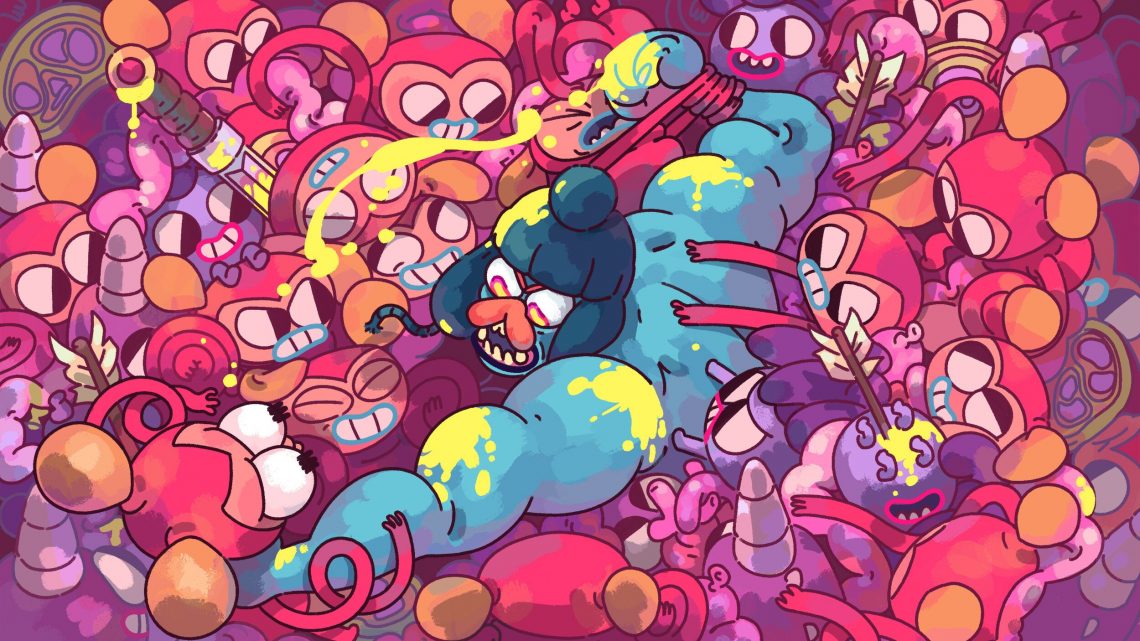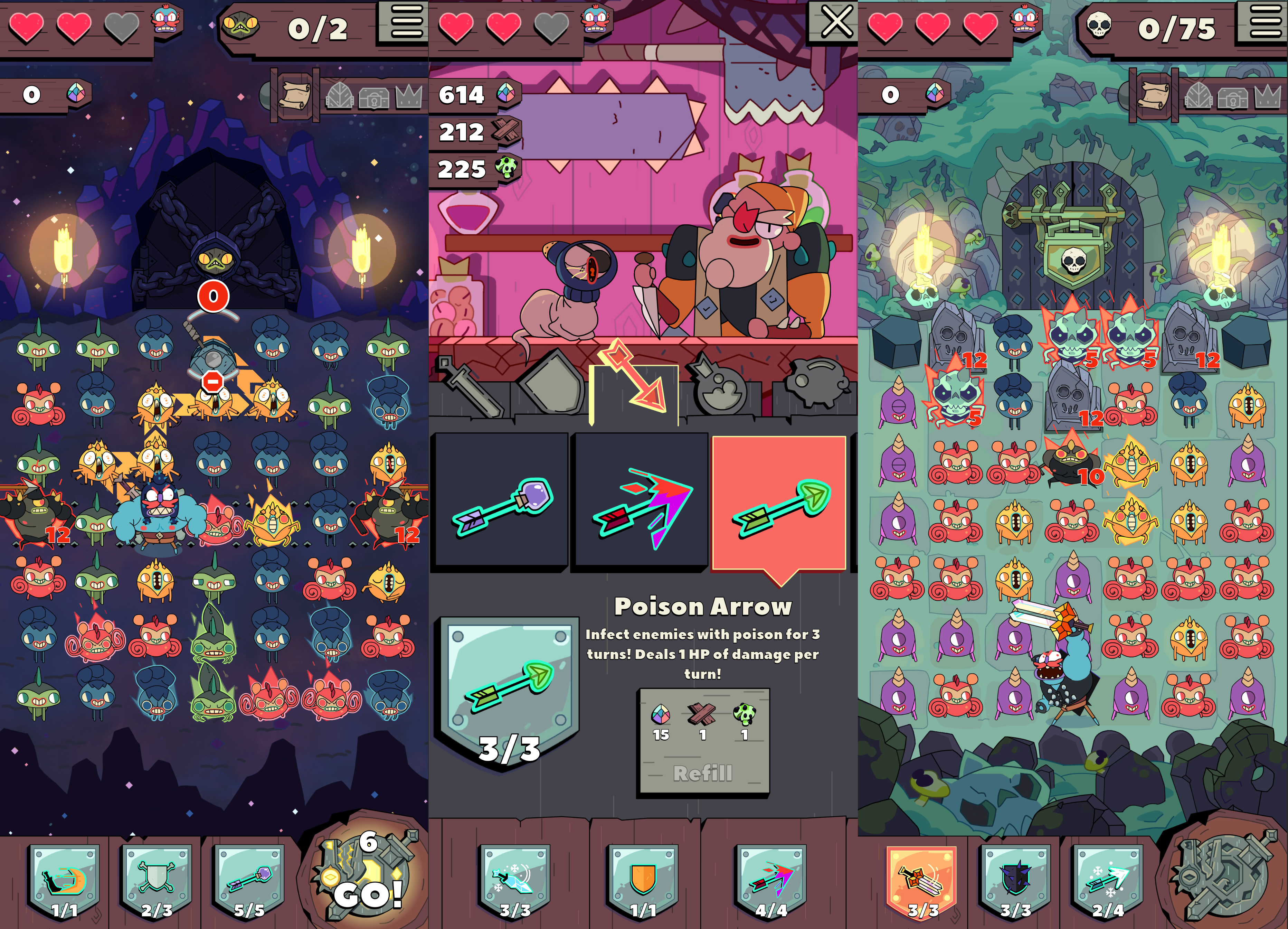
‘Grindstone’ Is a Perfect Puzzler to Showcase Apple Arcade’s Promise
September 23, 2019There used to be a time when I’d wake up every morning and excitedly checked Apple’s App Store, to see what surprises games might be waiting. Sure, there was a lot of junk, but there were enough revelations to justify genuine excitement about the platform’s future. Device 6! Spaceteam! Flappy Bird! Like the Wii, the iPhone’s unique interface promised new kinds of games we hadn’t seen before. At some point, a time I cannot exactly pinpoint but definitely a few years back, I basically stopped playing mobile games. My “games” folder is full of stuff from five years ago. I didn’t trust when a game was free, and felt the balance was tilted to spending more money. Then, the Switch came along, giving me console games on the go. I ghosted.
I know there are people who play games like Clash of Clans or Fire Emblem Heroes without spending obnoxious amounts of money, but every time I booted those games up, I’d wish I could pay a few dollars for the entire game to be balanced around never spending another one. It was a mental hurdle I couldn’t get over, so I stopped trying. And so enters Apple Arcade, a new subscription service for the iPhone (and iPad and Mac and Apple TV) with a basic promise: for $5-per-month, a suite of games that will never, ever ask for more money.
Apple Arcade launched late last week with a huge lineup, and weirdly, without much fanfare about the real highlights. Why was Frogger on stage at that event, when Square Enix was making an RPG? My phone got very warm trying to download more than 40 things, a mixture of games on other platforms and many exclusive to the Apple. Since launch, even more have been added. It's a lot. This week, I’m trying to unpack Apple Arcade as I spend more time with it, and try to consider its potential problems. How are developers making money, which apparently will be paid out via a mixture of development funds and “engagement” tracking? What does a subscription service do to game design? Will Apple favor promoting Apple Arcade games over others?
As I work through those questions, I’m going to highlight five games that I’ve been spending time with, with a focus on the kinds of games that I might have avoided without Apple Arcade explicitly stating $5 is all I need to hand over per month. (Apple Arcade’s first month is free.)
My goal on the night I signed up for Apple Arcade was to play through a dozen or so games for a few minutes each, and then figure out where to go from there. Instead, I was forced to huddle up against a wall to keep my phone from dying because I’d spent the last three hours ignoring the latest Cubs meltdown on TV and playing round after round of Grindstone, the latest game from Capy Games (Below, Super Time Force). Grindstone is f’ing awesome.
The hook is dead simple. You’re tasked with creating paths through a sea of different colored enemies. The longer the path, the more bonuses that appear. The catch: you can only connect to enemies of the same color. However, string together enough enemies and a crystal drops, crystals that allow you to swap colors and go even further. The longer you stay on the board, the more chances there are to grab additional drops that can be used to buy items and upgrades, but it also means harder enemies start dropping in, and if you can’t make it to the exit—eventually, enemies start hitting back—you lose everything.
The act of tracing your fingers across a few enemies, then tracing back as your mind notices a better way through—that tiny, tactile joy reminded me of the early days of iPhone games. There is no reason Grindstone couldn’t be played and enjoyed on a controller, or with a mouse and keyboard, but it feels like a game that was conceived with the finger in mind.
And in typical Capy fashion, this dead simple hook is accompanied by style; Grindstone is a game that looks, sounds, and plays like a delight. The way enemies pop in horror as you start to chart a path forward, a path that will soon be covered by their cartoonish bloodshed, never ceases to make me crack a smile. Watching your goofy warrior rip through the board, dumping crystals and loot abound, is as satisfying the first time as it is the 100th time.
I’ve had this experience with mobile games before, though. The bones of the game are great, but the moment you start playing, it’s a ticking time bomb before you’re presented with a screen promising to give you another turn, another crack at the puzzle, if you either A) spent a few dollars or B) come back later. That doesn’t happen in Grindstone. When you die, you can immediately jump back into the fray. Which isn’t to say there aren’t grind-y elements to Grindstone—hell, it’s right in the name—but it feels balanced towards the difficulty curve.

Here’s how that works in Grindstone: you can take three hits before dying. Then, the game punts you to the main map with a single heart. Some special items, like arrows that can attack from across the map or a jump that lets you escape danger, require rare loot to be refilled. A trip to the shop and a few crystals later can bump your health up to two or three hearts, and it is possible to run out of those, forcing you to backtrack and run through a few old puzzles for more currency.
But again, four hours or so in, I haven’t been forced to do that; I’ve got plenty. The game even includes additional buffers to avoid being forced into the past, with mini-challenges to accomplish on each stage, like stringing together an extraordinary number of enemies or beating an area extremely fast. Upon completing a challenge, the game lets you pick what loot you’d like, including crystals.
It’s not hard to imagine a different version of Grindstone that was a lot more underhanded, still letting you use in-game currency for hearts but cranking up how much it costs and encouraging players to buy one-off lives or purchasing big stocks of resources for cash. That is, thankfully, not the version I’m playing. I’m just enjoying...the game. What a concept, right? So many mobile games feel like you’re fighting on two fronts, the game itself and the metagame of aggressive microtransactions. It’s entirely possible Grindstone’s difficulty curve gets out of whack later, but for now, I’m thinking about the next puzzle. That’s a good start.
Follow Patrick on Twitter. If you've got any Apple Arcade recommendations, drop an email: patrick.klepek@vice.com. He's also available privately on Signal.


